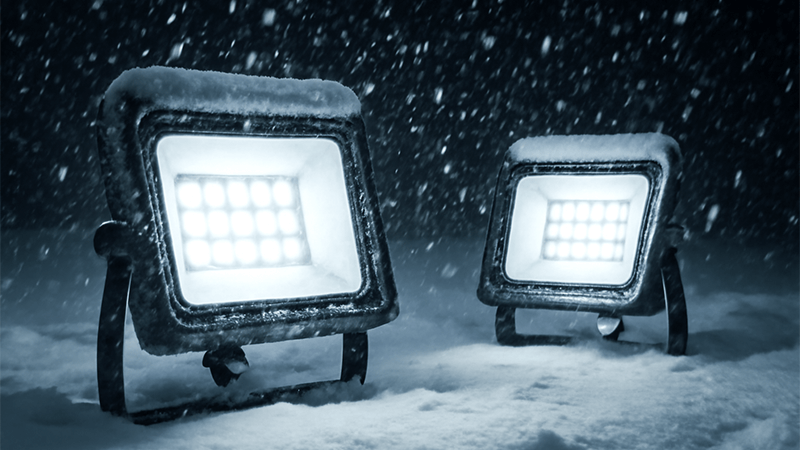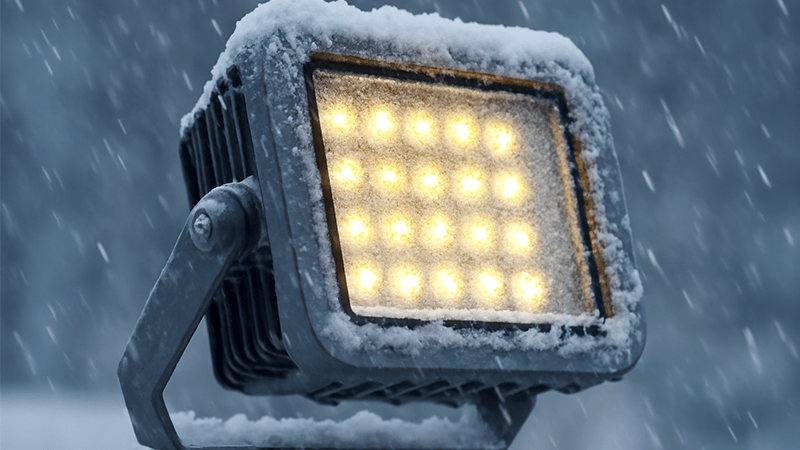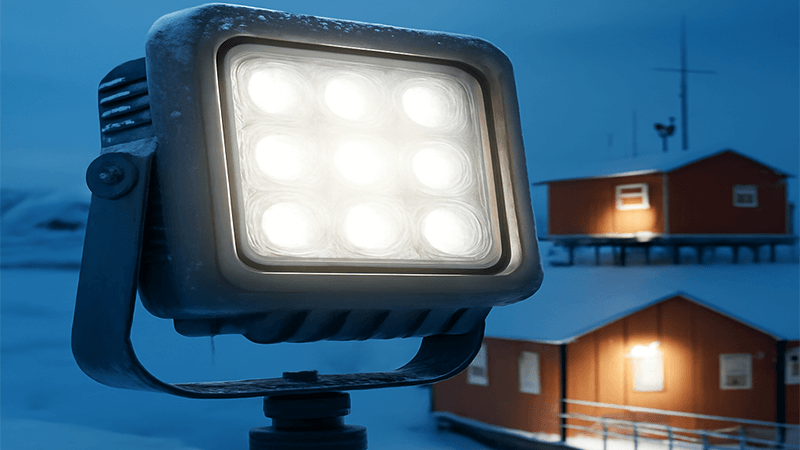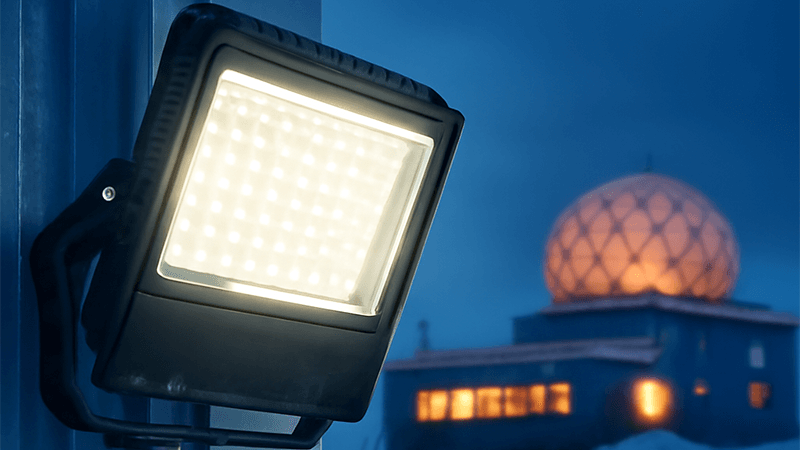Worried your floodlights will fail in winter? Failing lights mean costly replacements and unhappy clients. Choose LED floodlights built specifically for cold weather to ensure lasting, reliable performance.
The best LED floodlights for cold climates use low-temperature rated components. Look for robust housings (IP66+), reliable drivers, and flexible silicone or rubber cables instead of standard PVC. These features ensure your lights work safely and effectively, even in the most extreme freezing conditions.

Choosing the right floodlight for a cold climate seems simple, but there’s more to it than just picking a light that turns on. Over my years in manufacturing, I’ve seen many purchasing managers, like my friend Shaz who sources for global projects, get burned by lights that weren’t truly built for the cold. It’s not just about the LED chip itself. The entire system has to be designed to withstand freezing temperatures and moisture. Let’s break down what really matters when you’re sourcing for a project in a cold region.
Do LED flood lights work in cold weather?
Doubting if LED floodlights can handle the cold? The fear of flickering or complete failure is real, putting your project and reputation at risk. LEDs actually thrive in cold weather.
Yes, LED floodlights work very well in cold weather. In fact, cold temperatures can increase their efficiency and lifespan. The real issue isn’t the LED itself, but the surrounding components. The housing, driver, and especially the cables must be designed to withstand the cold without failing.

LEDs are semiconductors. Unlike older lighting technologies, their enemy is heat. Cold weather actually helps them run more efficiently by drawing heat away from the electronics. This improves their light output and extends their lifespan. So, the LED chip itself loves the cold. The problems begin with the other parts of the fixture that aren’t designed for it.
The weakest link is often the power cable. I once had a client from Canada call me in a panic. His entire installation of 100 floodlights failed after the first major freeze. We discovered the manufacturer used standard PVC cables. At -20°C, the PVC became brittle and cracked when moved by the wind. This exposed the wires, causing short circuits and creating a massive safety hazard. The solution was to replace them with lights that used cold-resistant rubber cables, which stay flexible even in deep-freeze conditions. It’s a detail that many overlook, but it’s critical.
Another point of failure is improper installation, often caused by poor instructions from the manufacturer. Materials contract in the cold. If a fixture is installed too rigidly without accounting for this thermal contraction, the stress can crack the housing or break the mounting brackets. A good manufacturer provides clear installation guidelines specific to cold environments, ensuring their product performs as promised.
Cable Performance in Cold Weather
| Feature |
Standard PVC Cable |
Low-Temperature Rubber/Silicone Cable |
| Flexibility at 0°C |
Stiffens slightly |
Remains flexible |
| Flexibility at -20°C |
Becomes brittle, prone to cracking |
Remains flexible and durable |
| Safety Risk |
High (cracks expose live wires) |
Low (insulation remains intact) |
| Best Use Case |
Temperate climates |
Cold and extreme cold climates |
What is the best lighting for cold weather?
Overwhelmed by lighting choices for a cold climate? A wrong decision leads to constant failures and wasted money. For unmatched reliability, specially designed LED lighting is your best possible choice.
High-quality LED fixtures are the best lighting for cold weather. They offer instant-on performance and improved efficiency in low temperatures, unlike older technologies. The most critical factors are choosing fixtures with cold-rated drivers, robust weatherproof housings (IP66+), and high-quality seals to prevent moisture damage.

When you compare lighting technologies for cold weather, LED is the clear winner. Older technologies like fluorescent and HID (High-Intensity Discharge) lamps have significant drawbacks. Fluorescent lights can struggle to start in the cold and offer reduced brightness. HID lamps require a long warm-up period to reach full intensity, which is not ideal for security or safety applications where you need light instantly.
LEDs, being solid-state, have none of these issues. They turn on to full brightness instantly, every time. But as I’ve said, the LED chip is only one part of the system. The electronic driver, which converts AC power to the DC power the LED needs, is just as important. A project contractor in Russia once contacted me because his new lights were flickering uncontrollably in the winter. We found that the capacitors inside the cheap drivers were not rated for -30°C temperatures. The cold caused them to provide unstable power, making the lights flicker and eventually fail. A quality cold-weather LED fixture uses drivers with components specifically chosen to operate reliably in a wide temperature range.
The housing and seals are also vital. As temperatures drop, materials shrink. A poorly designed fixture with low-quality gaskets will develop gaps. These gaps allow moist air to enter the fixture. When the temperature drops further, that moisture condenses and freezes, destroying the electronics inside. This is why a high IP (Ingress Protection) rating like IP66 or IP67 is non-negotiable. It means the fixture is sealed tight against both dust and powerful jets of water, which also means it can keep out damaging moisture in freezing conditions.
Do LED light bulbs work in cold temperatures?
Can a simple LED bulb survive a freezing winter? A burnt-out bulb means darkness and safety risks when you least expect it. The LED itself loves the cold.
Absolutely. LED bulbs work great in cold temperatures because the cold helps their internal components run more efficiently. The main concern is moisture, not the cold itself. Always use bulbs rated for outdoor or damp locations to protect the internal driver and electronics from condensation and freezing.

The science is the same for a small LED bulb as it is for a large floodlight: the semiconductor chip works better when it’s cold. The main difference is that all the electronics, including the driver, are packed into a much smaller space. This makes them just as vulnerable to the same problems, especially moisture. If you use an indoor-rated LED bulb in an outdoor fixture, it likely lacks the seals to prevent condensation. In a cold climate, that moisture will freeze, expand, and destroy the bulb’s internal driver from the inside out. That’s why you must look for bulbs with a UL or ETL listing for "wet locations" or "outdoor use."
However, there’s another challenge when buying bulbs or any LED product: misleading marketing. As a purchasing manager, you have to be wary of false claims. Many brands exaggerate performance to make a sale. I’ve personally tested products that claimed incredible energy savings, only to find they were barely more efficient than a standard bulb. For a large project, those small differences add up to a huge impact on the electricity bill.
Another common trick is to exaggerate the luminous efficacy (lumens per watt, or lm/W). A supplier might claim their floodlight produces 150 lm/W. But they don’t tell you that this number was measured in a perfect lab with the LED chip running by itself. It doesn’t account for the energy lost in the driver or the light lost in the fixture’s lens and reflector. The real-world, whole-fixture efficacy might only be 110 lm/W. For a professional buyer, you need to demand honest numbers. Ask for third-party test reports like LM-79, which measures the performance of the entire fixture, not just one component.
What kind of light bulbs are good for extreme cold weather?
Need lights for truly extreme cold? Standard options will crack and fail, creating dangerous, expensive problems. You need purpose-built, industrial-grade LED fixtures designed for the harshest conditions.
For extreme cold weather, you must choose specialized LED fixtures, not just bulbs. Key features include an explicit low-temperature rating (e.g., -40°C), silicone rubber cables, and drivers with military-grade components. A polycarbonate lens is also preferable to glass, as it resists becoming brittle.

When we talk about "extreme cold"—environments like Arctic research stations, industrial freezers, or oil rigs in the North Sea—we are in a completely different category. We are no longer talking about simple bulbs. We are talking about robust, industrial-grade lighting systems engineered to survive temperatures of -40°C and below. In these conditions, every single component is a potential point of failure.
I helped a client who managed an oil rig in the North Sea. They were using standard floodlights that were failing every few months from the cold, salt spray, and vibration. We designed a custom fixture from the ground up specifically for their environment. We used silicone rubber cables, a driver with components rated for -50°C, and a die-cast aluminum housing with marine-grade paint to prevent corrosion. Instead of a glass lens that could shatter from thermal shock, we used a thick polycarbonate lens that stays impact-resistant in the cold. Three years later, they have not had a single failure.
For a purchasing manager like Shaz, specifying for these projects requires extreme diligence. You cannot trust the claims on a product’s box. You need to look at the detailed specification sheet and know what to ask for.
Specification Checklist for Extreme Cold Weather LEDs
| Component |
Standard Specification |
Extreme Cold Specification |
| Power Cable |
PVC |
Silicone or Rubber (rated to -40°C or more) |
| Driver |
Standard components, 0°C to 40°C range |
Wide-temperature components, -40°C to 50°C range |
| Housing Material |
Standard Aluminum |
Die-cast aluminum with protective coating |
| Lens/Cover |
Glass or cheap acrylic |
Impact-resistant Polycarbonate (PC) |
| IP Rating |
IP65 |
IP66, IP67, or IP68 |
| Certifications |
CE, RoHS |
UL/ETL Wet Location, DLC Premium |
Conclusion
For cold climates, choose LEDs with quality components like rubber cables and rated drivers. Always verify manufacturer claims to ensure your lighting solution is reliable, safe, and truly built to last.